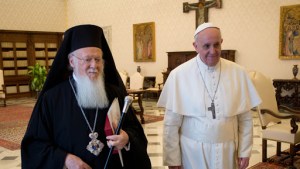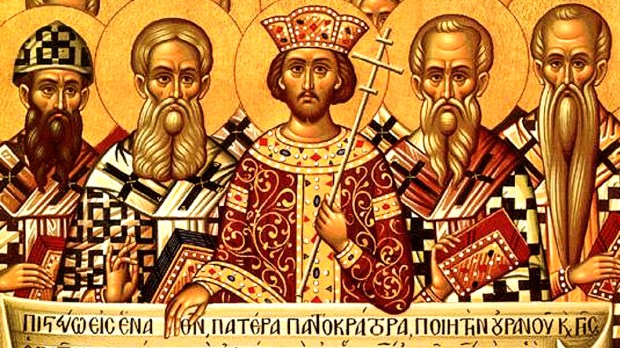In 1054, Pope Leo IX of Rome and Patriarch Michael I Kiroularious of Constantinople excommunicated each other. This mutual act crowned a number of East-West disputes, resulting in an East-West schism in the Church. Western dioceses remaining in union with Rome came to be known as Roman Catholic, while Eastern dioceses remaining loyal to Constantinople claimed the banner of Orthodoxy. Nearly 1,000 years went by before a joint Catholic-Orthodox commission was created to study the causes of the division and work toward possible reunification.
While the official schism between East and West can be pinned to 1054, the split was actually a long time in the making. Over centuries, Eastern and Western Christendom developed different theological emphases and liturgical practices, as well as differing notions of Church governance.
One of the key issues that drove East and West apart was the primacy of the Bishop of Rome. Eastern Christians did not deny that the See of Rome held primacy over all other churches, even Constantinople, but they did dispute the juridical claims that bishops of Rome were increasingly making regarding this primacy. A particular flashpoint in the debate can be seen in what is known as the Filioque Controversy. Beginning in the 7th century, some Western Christians added the phrase “and the Son” (filioque) to the Nicene Creed’s teaching that the Holy Spirit proceeds “from the Father.” Although Eastern and Western Church Fathers affirmed that the Holy Spirit proceeds from the Father and the Son, Eastern Christians objected to the pope’s adoption of the phrase “and the Son” into the Roman liturgy in the early 11th century. They argued that the pope alone has no authority to change what a church council—in this case, the Council of Nicaea—had decreed.
Other issues aggravating tensions between Eastern and Western Christians were different approaches to sacramental discipline and clerical celibacy.
Nevertheless, if Pope Francis could tell a Lutheran delegation last year that “what unites us is far greater than what divides us,” then we should apply his words particularly to members of the Orthodox Church. Orthodoxy retains a true apostolic succession among its bishops, and thus its bishops and priests celebrate the sacraments validly. Also together with Roman Catholics, Orthodox Christians revere the Blessed Mother, they foster devotion to the saints (especially the martyrs), and they fast and feast according to the seasons of the liturgical year.
With so much in common, and given Christ’s prayer and wish that his children “might all be one” (Jn 17:21), Catholic and Orthodox pastors today rightly dedicate themselves to constructive dialogue, with the aim of a return to unity.
The journey toward reunification began officially in 1964 when Pope Paul VI and Ecumenical Patriarch Athenagoras I of Constantinople met for the first time in Jerusalem. The following year they signed a joint declaration lifting the sentences of excommunication their predecessors had conferred on each other 900 years before. Since then popes and Eastern patriarchs have exchanged visits and signed declarations on a variety of occasions, most recently on September 1, the World Day of Prayer for the Care of Creation, a day observed by both Rome and Constantinople.
It 1979 Pope John Paul II and Ecumenical Patriarch Demetrios I formally established the Joint Commission for Theological Dialogue. The commission includes representatives from the Greek Orthodox patriarchates of Alexandria, Antioch, and Jerusalem, as well as the Russian Orthodox Patriarchate of Moscow and the Orthodox patriarchates of Serbia, Romania, Bulgaria, Greece, Poland, Albania, Finland and Estonia. Since the commission’s creation, 14 meetings have been held, which have produced nine documents of ecumenical importance.
The most recent document was issued in 2016. It studies the roles played by bishops, and in particular by the Bishop of Rome, in the first millennium, before the schism occurred. By remembering the shared past of East and West, the commission hopes to create common understanding of today’s circumstances.
With the 2016 document, an important phase of the joint commission’s work ended. A planning committee met in Greece earlier this month, September 5-7, to develop possible agendas for future meetings.

Read more:
Catholic-Orthodox Communion: The Goal of Francis and Bartholomew
In his address last year to Patriarch Bartholomew of Constantinople for the feast of St. Andrew, held as a patron by the Orthodox, Francis said noted that the journey will continue, sustained much more from heaven than by efforts on earth.
“In this journey towards the restoration of eucharistic communion between us, we are sustained by the intercession not only of our patron saints, but by the array of martyrs from every age,” he said, “who ‘despite the tragedy of our divisions… have preserved an attachment to Christ and to the Father so radical and absolute as to lead even to the shedding of blood’ (Saint Pope John Paul II, Ut unum sint, 83).”

